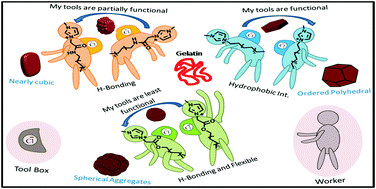Effect of alkyl chain functionalization of ionic liquid surfactants on the complexation and self-assembling behavior of polyampholyte gelatin in aqueous medium†
Abstract
The complexation behaviour of an imidazolium based ionic liquid surfactant (ILS) 3-methyl-1-dodecylimidazolium chloride, [C12mim][Cl], and its amide and ester functionalized counterparts 3-(2-(dodecylamino)-2-oxoethyl)-1-methyl-1H-imidazol-3-ium chloride, [C12Amim][Cl], and 3-methyl-1-dodecyloxycarbonylmethylimidazolium chloride, [C12Emim][Cl], with a model protein gelatin (G) in aqueous solution has been investigated. Complexation of G with ILSs at the air–solution interface has been monitored by tensiometry, whereas complexation and ILS mediated self-assembly of G–ILS complexes in the bulk have been followed by dynamic light scattering (DLS), zeta-potential measurements, conductivity, and fluorescence techniques. The morphology of different self-assembled architectures has been monitored by scanning electron microscopy (SEM). Different transitions observed from various techniques in different concentration regimes of ILSs have been assigned to the varying extent of complexation and ILS mediated self-assembly of G–ILS complexes. The functionalization of the alkyl chain of the ILS [C12mim][Cl] with an amide ([C12Amim][Cl]) or ester ([C12Emim][Cl]) moiety owing to their additional hydrogen bonding (H-bonding) ability along with rigidity ([C12Amim][Cl]) or flexibility ([C12Emim][Cl]) near the imidazolium head group has been found to exert great influence on their complexation with G. This influence is fashioned as self-assembled structures of G–ILS complexes into discrete large hexagonal sheet-like or near spherical architectures, depending on the concentration and type of functionality of the alkyl chain of ILSs. The thermodynamic forces behind the complexation and self-assembly processes have been monitored by isothermal titration calorimetry (ITC) measurements and are discussed in detail. As both the nature of the ILS and protein (charge and structure) could affect their interactional behavior, the present results are expected to be very useful in deeply understanding the structure–property relationship between the nature of the ILS and proteins, which would be of great importance in the field of functional soft-materials.


 Please wait while we load your content...
Please wait while we load your content...